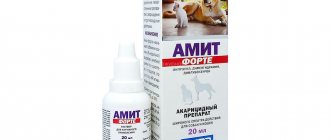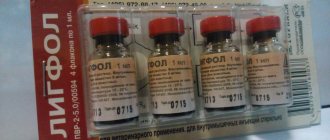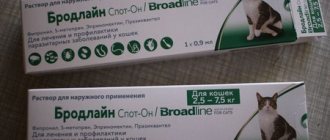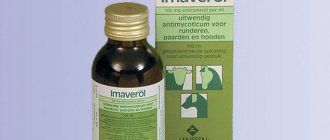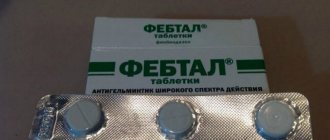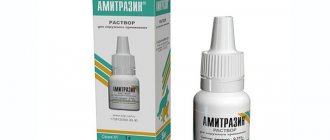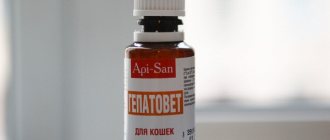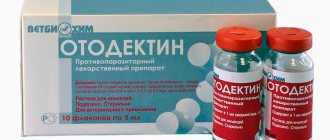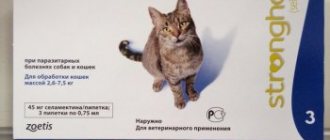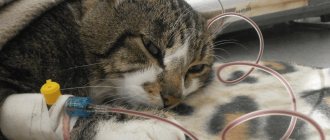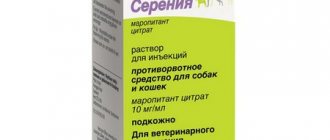When a furry pet appears in the house, the owner strives to show care. But you need not only to feed the animal correctly, play with it and give vitamin supplements. It is equally important to take care of your cat's fur in order to notice uninvited guests in the form of fleas and ticks in time. Insects cause discomfort to your pet and can be dangerous to humans. The behavior of the animal will indicate the infection. The cat becomes nervous, often jumps and scratches. For such cases, you can have the drug “Fiprist” for cats in the house. The instructions show that rapid cleansing of parasites occurs and the animal’s life returns to normal.
Description of the drug
Fiprist is an antiparasitic drug intended for external use. The active component of the product is fipronil, which leads to the death of harmful insects that parasitize pets. The medication is available in two dosage forms: spray and drops. The manufacturer offers two types of drops: Spot-On and Combo, which differ in composition. The combo is an improved version. This type of drug contains S-methoprene, the action of which is directed both against sexually mature individuals and against eggs and larvae of parasites.
All forms of the drug are highly effective and harmless. The spray contains, in addition to the active ingredients, distilled water, isopropanol and copovidone. The medicine in the form of a spray is available in bottles of different sizes (100, 250, 500 ml). To treat a cat, 100 ml of product is required.
Spot-ON and Combo drops differ from the spray in composition. Drops are produced in the form of a solution, packaged in polymer disposable pipettes with different volumes (from 0.5, 0.67, 1.34, 2.68 to 4.02 ml). Pipettes are packed in a cardboard box, 3 in each. Thanks to its convenient form, it is very easy to use the drug; you need to apply the solution directly from the pipette. For cats, the drug is used in the form of drops with a volume of 0.5 ml. This solution contains 50 mg of fipronil. Drops are also produced in a different dose for dogs. When purchasing, you must be careful and make the right choice for the intended purpose, since exceeding the dose can lead to intoxication.
As auxiliary components, the drug contains povidone, polysorbate, butylhydroxyanazole, butylhydrotoluene, dimethyl sulfoxide.
The product can be stored for no more than 3 years from the date of release. Drops should be stored in a place protected from light at a temperature of 0-25 degrees. It is necessary to store the drug out of the reach of children and animals, since the composition contains toxic components.
Spot-On
This is one of the types of the drug Fiprist, produced in the form of drops. Insectoacaricidal preparation of contact action. Active against all phases of development of lice, fleas, lice and ticks (ixodic, cheylitella, otodectos), parasitizing dogs and cats.
In terms of the degree of impact on the body, Fiprist Spot-On is classified as a moderately hazardous substance (class 3). The drug contains fipronil (100 m)g, povidone, polysorbate, butylhydroxyanisole, butylhydrotoluene, dimethyl sulfoxide.
Combo
This type of drug is a combined insectoacaricidal agent with contact action. Contains fipronil and S-methoprene as active ingredients.
Fipronil is an insectoacaricide of the phenylpyrazoles group; the mechanism of contact action is to block GABA-dependent arthropod receptors and disrupt the transmission of nerve impulses, which leads to paralysis and death of ectoparasites.
Methoprene is an analogue of juvenile hormone, an insect growth regulator. The substance disrupts the synthesis of chitin, causes abnormalities in the development of insects at the egg and larval stages, preventing the appearance of mature insects on pets and in their place of residence.
Spray
This form of the drug is available in bottles and differs in composition. One bottle of the drug contains fipronil (0.25%), as well as excipients: copovidone (2%), isopropanol (80%), distilled water.
Packaged in polyethylene bottles with a spray head, each bottle contains 100ml, 250ml or 500ml of product.
The drug is easily dosed:
- one click on the sprayer of a 100 ml bottle provides a dose of 0.5 ml;
- one click on the sprayer of a 250 ml bottle provides a dose of 1.5 ml;
- One press on the sprayer of a 500 ml bottle provides a dose of 3 ml.
The spray is applied to the entire body of the animal against hair growth, slightly moisturizing the fur (in cats of long-haired breeds, the hair should be lifted with your hand). Covering the cat's eyes, treat the ears and chest, lightly rub the drug around the eyes and nose with your fingertips. The procedure must be carried out with rubber gloves.
Purpose
The medicine is used for a single treatment of animals over 2 months of age in the following cases of infection with ectoparasites:
- with otodectosis;
- entomoses;
- infestation by ixodid ticks.
Most often, dogs are attacked by fleas. And even if the animal practically does not leave the apartment, a person can be a carrier: on clothes or shoes, he can bring home a parasite that will cause concern for the pet. Small insects that settle on the animal’s body and fur feed on its blood, and they:
- They are carriers of diseases;
- Infected with worm eggs;
- May cause anemia in puppies.
Flea saliva is a strong allergen, which causes anxiety in the animal, itching, and scratching. Damage to the skin leads to the development of infection and dermatitis. Fleas serve as carriers of dangerous diseases such as distemper, tularemia, salmonellosis, pasteurellosis, and dipylidia (the latter can also be contracted by humans from a pet).
Otodectosis
is a common disease in dogs caused by infection with ear mites. The causative agent of ear scabies is the microscopic mite Otodectes cynotis. Once in the external auditory canal, it feeds on the scales of the epidermis, and the results of its vital activity lead to irritation of the delicate skin of the auricle and itching. The dog scratches the ear until it bleeds, thereby opening up the infection, causing inflammation of the outer ear and purulent otitis media.
Follow us
Find out more about your animal's personality on our social networks
The causative agent of notoedrosis is the sarcoptoid mite of the species Notoedres cati. The pathology is manifested by chronic inflammation of the animal’s scalp, hair loss, and baldness. The parasite bites into the deep layers of the skin, makes passages in it, and moving along them causes itching in the animal.
The danger of the disease lies in its consequences:
- disorders of the central nervous and cardiovascular systems;
- impaired skin respiration;
- oxygen deficiency, etc.
Ticks of the genus Cheyletiella cause cheyletiellosis. It manifests itself as skin peeling, itching and irritation.
Bites from fleas and ticks that parasitize animals cause them a lot of anxiety: dogs become irritable and nervous. Sleep is disturbed, appetite decreases, and the pet’s appearance deteriorates. Fiprist is capable of destroying ectoparasites after just one treatment, restoring calm to your pet.
Action
The mechanism of action of the drug Fiprist is due to the influence of the active component on the nervous system of the parasite. Under the influence of the drug, insects pedal. As a result of the action of the drug, the tick disappears on its own after a few hours, the same thing happens with fleas and lice eaters. If used correctly, you can get rid of all parasites with the help of the drug within a day.
After application, the drug is quickly absorbed into the skin without penetrating into the systemic bloodstream, due to which the product is considered safe and does not affect the pet’s important organs.
After application, the active component begins to be evenly distributed over the entire surface of the body, accumulating in the sebaceous glands, hair and in the upper layer of the epidermis, which determines the long-lasting effect of the medicine.
The drug has certain properties that ensure its safety for mammals and active effect on parasitic insects:
- blocking GABA parasite receptors;
- paralysis of the nervous system of arthropods.
Fiprist combo for cats and ferrets
The drug is released in 0.5 ml pipettes.
Cost in September 2021 - 346 rubles.
After application to the skin, the components accumulate in the hair, sebaceous glands, hairs, and epidermis. Fiprist combo protects cats from repeated attacks of parasites for 4 weeks, ferrets - for 6 weeks.
Licking should not be allowed. To do this, the jaws are closed and secured with a ribbon, or an Elizabethan collar is put on. The treated pet is isolated from other animals. Do not allow the coat to get wet for 2 days after treatment. Children are explained why the pet should not be petted within 24 hours after disinfestation.
Fiprist combo cannot be used in the following cases:
- the kitten is up to 8 weeks old, its live weight is less than 1 kg;
- ferret is less than six months old.
Instructions for use and dosage
The method of application depends on the form of release of the drug. However, Fiprist should be used following some general rules. Necessary:
- buy a special collar to prevent licking of the medicine. This is very important, since ingestion of the drug can cause severe intoxication;
- do not bathe the cat for 48 hours after treatment;
- During the procedure, avoid getting the product into your eyes to prevent severe irritation;
- be sure to treat the cat’s bedding, mattress, and place of residence to prevent re-infection;
- treat all pets to prevent the spread of parasitic infection;
- carry out manipulations with rubber gloves.
While processing the animal, it is not allowed to drink, eat, or smoke. If the solution gets on the mucous membranes, remove the substance with a cotton swab and wash the corresponding area with warm soapy water.
After the procedure, the pipette/vial of the drug must be disposed of with household waste. If there are residues after the procedure, they must be poured down the drain, since the components of the product are toxic.
Fiprist should be applied once to dry skin, after checking that there is no damage. The product should be applied at several points on the cat's back and between the shoulder blades. The pipette can be used easily by unscrewing the cap and turning the pipette. Thanks to the ergonomic design, the medicine does not spill.
For cats, regardless of weight, use one pipette with a volume of 0.5 ml. The drug retains its protective function for 1.5 months.
If a cat is infected with ear mites, you need to drip 4-6 drops of the product into both ears. After the product is dripped, you need to carefully bend the ear in half and massage lightly so that the drops are distributed correctly. If there is any product left after the procedure, it can be dripped onto the withers. The drug is strictly forbidden to use if the cat has a perforated eardrum. It is recommended that ear treatment be done in a clinic, since only a specialist can determine the severity of the problem and perform the manipulation safely.
The cat must not be bathed for 48 hours after treatment. Contact with the treated pet is not allowed, especially children and people prone to allergic reactions.
- Spot-On
One pipette is provided for one-time use. The drug is used by single topical application to dry, intact skin. The volume of the cat pipette used is 0.5 ml (containing 50 mg of fipronil).
The duration of action of the drug against ixodid ticks is 15-21 days, the protective period is 1.5 months.
- Combo
The drug in the Combo version has methods of administration and dosage similar to the Spot-On form.
- Spray
The dose is determined depending on the length and thickness of the cat's fur. The recommended dose is 3-6 ml per kilogram of cat's weight. The spray can also be used to treat dogs.
During the processing process, you need to lift the wool with your hands and spray with spray from a spray bottle. You need to treat the chest and ears, first covering the cat’s eyes with your palm. After treatment, the cat should not be allowed near open fires or heating devices until the solution dries.
The spray must be used to treat the cat's bedding or house to prevent re-infestation. Bathing your pet is not allowed for 2 days after the procedure.
How to use drops
For fleas, lice and lice, the medicine is applied to the area between the shoulder blades once. In this case, it is important to spread the fur so that the solution gets directly onto the skin. For cats, the dose is not based on weight. The contents of one pipette must be used. After applying the product, the cat should not be bathed for several days. The effect of the medicine lasts about a month.
Apply drops to the area between the shoulder blades
If it is necessary to get rid of ear mites, the drug is instilled into the ear canal, after first clearing the area of scabs. The remainder of the solution is applied to the withers area, as described above. No more than 2–5 drops should be administered into each ear canal. In this case, it is recommended to fold the auricle in half and lightly massage it so that the drug is evenly distributed. In this case, the medication is also used once.
To instill the solution into a cat, you need to fold the ear in half.
Attention! In case of advanced otodectosis, it is recommended to additionally use antibacterial and anti-inflammatory medications, which will be prescribed by the doctor. This approach to treatment will speed up your pet’s recovery.
To prevent fleas in a cat, I used drops similar in effect. This medicine is very convenient to use. It is enough to squeeze the contents onto the skin in the withers area and you don’t have to wash it off. At the same time, existing parasites are eliminated, and infection from other animals is also prevented. The cat did not notice any negative side reactions to the drug.
Advantages of the drug
Fiprist has a number of advantages. A highly effective drug produced in Germany does not have a negative effect on the cat’s health, since it does not penetrate the systemic bloodstream.
Fiprist Spot-On has a pronounced insecticidal and acaricidal effect against all forms of lice, fleas, lice and ticks (ixodic, cheylitella, otodectos) parasitizing dogs and cats. This allows for a short period of time to completely eliminate parasites both on the animal’s body and in its habitat.
The advantages of the product also include the ability to choose the appropriate form and dose, since the drug is available in different forms, with different compositions and dosages. Using a spray head atomizer and a pipette makes the procedure simple and prevents you from making a mistake with the dose needed for your pet.
Storage and disposal:
Pipettes must be stored in a place where children do not have access, where there is no direct sunlight, and where the ambient temperature is between 0-25°C. Also, do not allow it to come into contact with or be near food for humans or food eaten by pets. From the moment of manufacture, Fiprist is good for 3 years; after the expiration date it cannot be used.
Disposal of the drug occurs according to local rules; current requirements are located in the current legislation of the region where it is used.
Contraindications and side effects
The drug contains insecticidal components and has some restrictions for use:
- Fiprist should not be used on kittens under 8 weeks of age;
- It is not allowed to use the product on sick and exhausted pets;
- Do not use in combination with other drugs with similar effects;
- The use of the drug in the presence of infectious diseases, as well as during the recovery period after them, is not allowed;
- It is not recommended to use the medication if the cat is individually intolerant to the components included in the drug.
Pregnant and lactating cats are allowed to use the drug only after consulting a doctor and examining the general health of the pet. The medication is not recommended for treating older animals.
The spray can be used to treat kittens from a week old, drops can be used after the kitten is 8 weeks old.
The drug Fiprist can cause side effects if the dose and application algorithm are violated. A negative reaction is detected in the form of allergies and skin irritation at the site of application of the product. In such cases, it is necessary to stop using the drug, and rinse the problem area with warm water, then treat with alcohol. If necessary, desensitizing therapy is prescribed.
Side effects can be recorded as a result of licking the treatment site. A negative reaction in such cases is manifested by vomiting, nausea, refusal to eat, apathy and depression. If these symptoms appear, you need to rinse the stomach and give the animal enterosorbents to remove toxic substances from the body.
General rules of application
Regardless of the release form, when using Fiprist, you should follow simple rules and recommendations:
- If you are treating several animals, exclude the possibility of licking the drug. To do this, use collars or mouth braid. You can remove them after the medicine has dried.
- Treat or change bedding and household items when killing parasites to prevent re-infestation.
- The dog should not be bathed 2 days before treatment and 48 hours after. Shampoos can reduce the effect of the product, so their use should be minimized.
- The drug should be applied to dry and undamaged skin.
- Carry out preventative treatment regularly. If the recommended regimen is violated, a decrease in the effectiveness of the drug may be observed.
It is strictly forbidden to combine Fiprist with other insectoacaricidal agents. This may cause increased toxicity and side effects.
Are Fiprist drugs safe?
All forms of the drug Fiprist are completely safe for pets because they are not absorbed into the systemic bloodstream. This is the reason why the drug is used for the treatment and prevention of pregnant females. The medication does not harm the health of the mother and fetus, and protects the cat from harmful parasites that can cause the development of serious infectious diseases that are life-threatening.
The drug contains quite strong components, and therefore it is recommended to do the treatment in a room with open windows and wearing rubber gloves. After manipulation, hands should be washed with warm water and soap, and the pipette or bottle should be disposed of. If these simple rules are followed, the drug does not harm the health of the pet and its owner.
When is the medication prescribed?
The drug is prescribed to eliminate parasites such as:
- fleas;
- lice;
- lice eaters;
- cheyletiella;
- ticks.
The drug allows you to rid your cat of fleas
The medication is used not only for treatment, but also to prevent re-infection. It is important to periodically use this product to prevent the appearance of fleas and ticks if the animal is often outdoors.
Attention! Prevention of flea infestation is extremely important for a pet, since these parasites are carriers of helminths and can cause severe dermatological diseases.
Analogs
The antiparasitic drug Fiprist can be replaced with analogues if there are specific contraindications for the use of the medication. Before using the analogue, you should consult a veterinarian.
Analogues of Fiprist include:
- Leopard for fleas and ticks. Available in spray form. The active component of the drug is fipronil. Effective against ticks and lice;
- Advantage. Release form: drops. The active ingredient is imidacloprid. Effective when your pet is infected with ticks, fleas and lice-eaters;
- Frontline. Release form: drops. The active ingredient is fipronil. Helps eliminate fleas, worms, ticks.
Owner reviews
Marina, owner of a 2-year-old dog:
“Our dog is not purebred, but we love it very much. When at the beginning of summer, our shaggy miracle began to itch, we immediately went to the pharmacy. On the advice of the pharmacist, we bought Fiprist drops. It’s a convenient tool for processing, but it didn’t help us. After a while, the dog continued to itch, so I had to repeat the treatment, but with a different remedy. True, this is a completely different story.”
Victoria, pinscher owner:
“We always carry out preventive treatment of the dog against fleas and ticks. When we moved into the house we bought, it turned out that fleas lived in the wooden floor. They began to annoy our Jack, so they went to the pharmacy to get an effective drug. We bought the Fiprist combo. The pharmacist said that it contains two active substances, and it copes with its functions perfectly, affecting not only fleas and ticks, but also their larvae. After a week there was not a single flea in the house, and the dog felt great.”
Answers to popular questions
Cat and dog owners interested in the health of their pets constantly ask questions regarding the use of antiparasitic agents, since clean skin is the key to good health of their pets.
- Is it possible to scratch after treatment?
After treatment, contact with the pet, especially rough contact in the form of scratching, is strictly prohibited, since the substance applied to the skin is poisonous. It can penetrate the skin into the body and cause intoxication. You need to wait until the product dries and avoid contact with the animal for 2-4 days.
- Can it be used on a dog?
The drug Fiprist is available in special doses. There is also a dosage for the treatment and prevention of dogs. When choosing a drug, you need to be careful and purchase the right form and dose intended for dogs.
- Is it possible to divide by less?
The drug is available in an already dosed form and dividing it into smaller doses can lead to a decrease in effectiveness or an increase in dose, which is especially dangerous for the pet. The company produces mini doses on a separate line. The product is not yet widely available. The terms of purchase can be found on the manufacturer’s official website.
- Is it okay for pregnant cats?
The use of the drug Fiprist for the treatment and prevention of pregnant cats is permitted only after consultation with a veterinarian. Basically, the answer is positive, since the drug does not penetrate the bloodstream and is safe for the fetus.
- Is it possible to put drops in the ear?
Fiprist is used to treat ear mites. The drug should be dripped into the ear strictly according to the dose indicated in the instructions. Both ears need to be treated at once. It is advisable to entrust the procedure to a veterinarian who will carry it out in a clinic, since before dripping the drug you need to clean your pet’s ears until they are completely clean and check the integrity of the eardrum. If the membrane is perforated, dripping the drug is strictly prohibited.
- Is it possible to pet a cat?
The cat can be stroked, hugged and caressed only 2-4 days after the procedure. Immediately after treatment, you should not touch the cat. It is necessary to exclude contact of children and people prone to allergies with the treated animal.
- Is it possible to wash a cat?
It is not recommended to wash the animal 2 days before treatment, and also to wash and bathe it within 2 days after treatment.
- Is it suitable for a nursing cat?
The drug Fiprist is allowed to be used during lactation, since it does not penetrate into mother's milk and cannot cause a negative reaction in the kitten.
Special instructions and precautions
What you need to consider when working with the drug:
- It is important to shake the bottle before using the spray.
- You need to cover the cat's eyes with your palm to prevent the medicine from getting on the mucous membranes.
- It is not recommended to bathe the animal 2 days before using the drug.
- When applying the spray, keep the bottle vertical.
- When working with medicine, be sure to wear gloves.
- It is advisable to spray the spray with the windows open. Inhaling vapors is not recommended.
- After treating the animal, be sure to wash the bedding at high temperature.
- After finishing handling the medication, it is important to wash your hands thoroughly.
- During treatment, smoking and eating are prohibited.
- If the solution accidentally gets on your skin, you need to quickly wipe it off with a cotton swab and thoroughly wash the area with soap.
It is important to wash the bedding on which the cat sleeps thoroughly to prevent re-infection.
Attention! Use spray and drops only away from fire and heat sources.
Veterinarian's opinion
People for whom the health of their pets is important bring their pets to the veterinary clinic. To treat cats and dogs for ectoparasites, the modern drug Fiprist is most often used, which has been tested and has many positive reviews from pet owners. The drug is available in different forms; Fiprist Combo with an improved composition is more effective. Fiprist spray is also effective, which allows you to treat not only your pet, but also his things and the house where he lives. This treatment prevents re-infection.
The effect of the drug lasts about 1.5 months. Repeated treatment, as a rule, is not required, since after the first application of the product the parasitic insects die. The drug is safe for mammals and has no side effects, provided that the instructions in the instructions are followed exactly.
All types of Fiprist are effective and harmless. The product is used by both cat owners and experienced veterinarians.
How to use the spray
Before applying the spray, it is important to put a cervical collar on your pet, which will prevent the animal from licking the medicine. The dose of the drug depends on weight. Per 1 kg there should be from 3 to 6 ml of product. Your veterinarian will help determine the exact amount. The medicine should be sprayed evenly at a distance of 20 cm from the fur. The collar cannot be removed until the solution has dried. It is recommended to bathe your pet no earlier than after 2 days. The spray can be reused after a month.
The cervical collar will prevent licking of the drug
Attention! It is important to spray not only the animal, but also its bedding. Otherwise, re-infection may occur.
